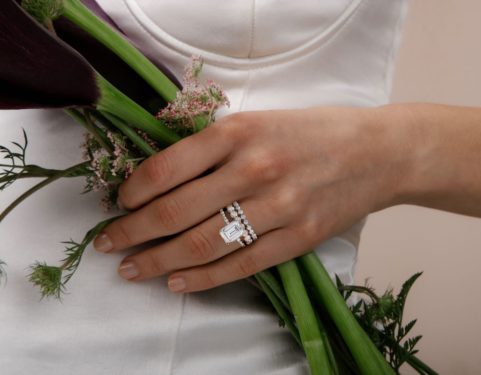The Baguette diamond is high in demand for everything from engagement rings to fine jewelry like earrings, and bracelets. And while they may seem like a new style, this diamond cut was actually introduced during the 1920’s Art Deco era. It was named for its elongated shape, after the classic French baguette. The baguette diamond is a thin, rectangular-shaped diamond with tapered or straight edges. These are referred to as “straight” or “tapered” Baguettes. These elongated diamonds are the perfect addition to many engagement ring styles and are often seen as accent diamonds.
Baguette diamonds have 14 facets, which is much less than any other diamond cut. Round diamonds, for example, feature 58 facets which are why round cut diamonds are known for their brilliance. Facets measure a stone’s brilliance and scintillation, or the amount of sparkle that is produced by that diamond. More facets equal more sparkle. Baguette diamonds have a step-cut because of their long, open facets that look similar to steps. While Baguette diamonds have fewer facets, they do have exceptional clarity.
Baguette Diamond vs. Emerald Cut Diamond
Baguette and emerald-cut diamonds are often confused because of their similar appearance, especially when they are smaller. Both are part of the step cut family, along with Asscher diamonds, which are usually square or rectangular in shape. With their elongated rectangular shape and long facets, these diamonds produce a hall of mirrors effect, or prismatic reflection, rather than a brilliant sparkle. However, while baguette diamonds feature only 14 facets, emerald cut diamonds feature over 50. Emerald cut diamonds can stand on their own as a center stone in emerald cut engagement rings, but baguette diamond rings typically feature the baguette cut diamond as an accent or side stone.
How To Shop For a Baguette Diamond
Baguette diamonds have fewer facets, and therefore fewer cuts, so it’s important to look for a baguette diamond that has higher cut and clarity grades. Since you typically see Baguettes used as smaller accent stones, be sure to choose a baguette diamond that matches when laid next to another. There are a few key tips to remember if you’re choosing to use baguette diamonds as the focal point on your engagement ring.
- First, remember the sparkle won’t be as great as compared to a brilliant round cut diamond.
- Second, you can easily see inclusions and flaws on this cut diamond. Make sure that when choosing a baguette diamond ring, no imperfections are visible to the naked eye.
- Finally, get baguette diamond side stones with a diamond color that is no more than one grade higher or lower than your center stone.
Are Baguette Diamonds Expensive?
Like all diamond shapes, we grade Baguette-cut diamonds based on the 4’C’s, which will impact their price. Typically, baguette diamonds are used as side stones and therefore come in smaller carat weights, making them generally less expensive. However, a baguette diamond can become more expensive if you choose a larger carat because they are more difficult to cut from the rough diamond. But if you’re looking for a smaller Baguette diamond either to accent your diamond engagement ring or for a stacking ring, it will cost less than a round brilliant diamond. And remember, lab-created diamonds can be anywhere from 20-40% less expensive than mined diamonds.
Are Baguette Diamonds Good?
While a stunning cut, Baguette diamonds are generally among lower quality diamond cuts compared to other diamond shapes. They have less brilliance, due to the lower amount of facets, and can also be easier to damage. However, this isn’t to say you should avoid this diamond cut. They can be a great and lower cost option if you’re looking to add more diamonds to your wedding band or engagement ring.
Baguette Engagement Ring Settings
While there are a few cons to a baguette diamond ring, it’s still possible to incorporate them into your engagement ring. There are many beautiful engagement ring styles that pair well with baguette diamonds. You can play around with diamond shape, center diamond, and ring setting to create your perfect ring. If you’re looking to add a baguette diamond, explore these options, below!
Three-stone
The three stone diamond is the most popular choice for Baguette-cut diamonds and the perfect example of how to use Baguette diamonds as accent stones. For three-stone settings, you’ll see both tapered baguette diamonds or even baguette diamonds that are east/west facing. We’d recommend choosing another step-cut diamond as your center stone, to perfectly compliment the two Baguette stones.
Channel
Channel set engagement rings allow the ring-wearer to have this delicate cut securely set inside the band. Baguette diamonds are perfect for this setting style because when placed end-to-end, it gives your band the illusion of endless diamond along your band. The perfect way to add extra sparkle to your diamond. And because channel set diamonds are more protected, you won’t have to worry about damaging your delicate baguettes.
Vintage
Another perfect choice for Baguette diamonds is vintage style settings. Jewelers originally created this cut in the Art Deco era, we love this diamond-cut paired with a geometric style setting. This is also a great option if you’re looking to add a more delicate sparkle to your elaborate vintage setting.
Wedding Bands
Baguette wedding and fashion rings are becoming more and more popular, and we can see why! The straight row of diamonds offers an elegant look to any band in any metal color. Also, because baguette diamonds typically cost less, this is a great choice if you’re looking to keep the cost down on your wedding band.



